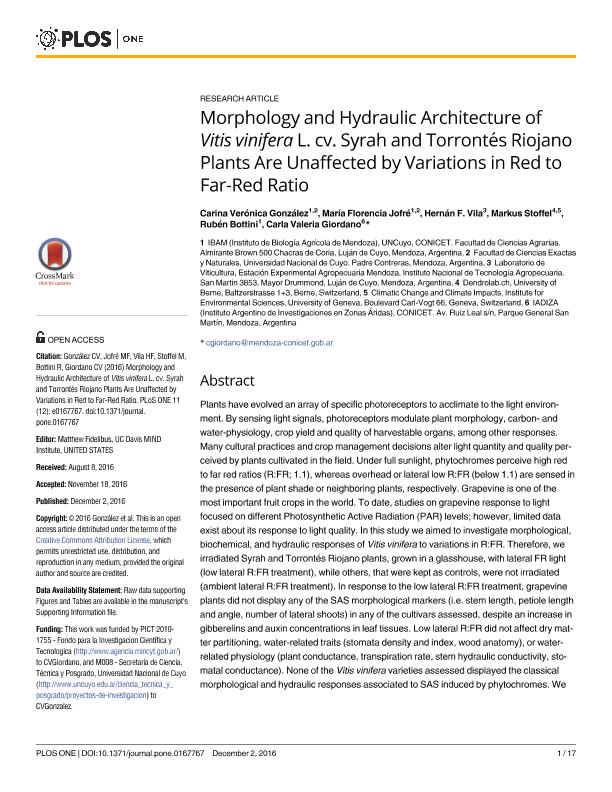Mostrar el registro sencillo del ítem
dc.contributor.author
Gonzalez, Carina Veronica

dc.contributor.author
Jofré, María Florencia

dc.contributor.author
Vila, Hernán Félix

dc.contributor.author
Stoffel, Markus
dc.contributor.author
Bottini, Ambrosio Rubén

dc.contributor.author
Giordano, Carla Valeria

dc.date.available
2018-03-26T18:34:32Z
dc.date.issued
2016-12
dc.identifier.citation
Gonzalez, Carina Veronica; Jofré, María Florencia; Vila, Hernán Félix; Stoffel, Markus; Bottini, Ambrosio Rubén; et al.; Morphology and hydraulic architecture of vitis vinifera L. cv. syrah and torrontés riojano plants are unaffected by variations in red to far-red ratio; Public Library of Science; Plos One; 11; 12; 12-2016; 1-17; e0167767
dc.identifier.issn
1932-6203
dc.identifier.uri
http://hdl.handle.net/11336/39953
dc.description.abstract
Plants have evolved an array of specific photoreceptors to acclimate to the light environment. By sensing light signals, photoreceptors modulate plant morphology, carbon- and water-physiology, crop yield and quality of harvestable organs, among other responses. Many cultural practices and crop management decisions alter light quantity and quality perceived by plants cultivated in the field. Under full sunlight, phytochromes perceive high red to far red ratios (R:FR; 1.1), whereas overhead or lateral low R:FR (below 1.1) are sensed in the presence of plant shade or neighboring plants, respectively. Grapevine is one of the most important fruit crops in the world. To date, studies on grapevine response to light focused on different Photosynthetic Active Radiation (PAR) levels; however, limited data exist about its response to light quality. In this study we aimed to investigate morphological, biochemical, and hydraulic responses of Vitis vinifera to variations in R:FR. Therefore, we irradiated Syrah and Torrontés Riojano plants, grown in a glasshouse, with lateral FR light (low lateral R:FR treatment), while others, that were kept as controls, were not irradiated (ambient lateral R:FR treatment). In response to the low lateral R:FR treatment, grapevine plants did not display any of the SAS morphological markers (i.e. stem length, petiole length and angle, number of lateral shoots) in any of the cultivars assessed, despite an increase in gibberelins and auxin concentrations in leaf tissues. Low lateral R:FR did not affect dry matter partitioning, water-related traits (stomata density and index, wood anatomy), or waterrelated physiology (plant conductance, transpiration rate, stem hydraulic conductivity, stomatal conductance). None of the Vitis vinifera varieties assessed displayed the classical morphological and hydraulic responses associated to SAS induced by phytochromes. We discuss these results in the context of natural grapevine environment and agronomical relevance. Copyright:
dc.format
application/pdf
dc.language.iso
eng
dc.publisher
Public Library of Science

dc.rights
info:eu-repo/semantics/openAccess
dc.rights.uri
https://creativecommons.org/licenses/by/2.5/ar/
dc.subject
Vitis Vinifera
dc.subject
Phytochorme
dc.subject.classification
Otras Ciencias Biológicas

dc.subject.classification
Ciencias Biológicas

dc.subject.classification
CIENCIAS NATURALES Y EXACTAS

dc.title
Morphology and hydraulic architecture of vitis vinifera L. cv. syrah and torrontés riojano plants are unaffected by variations in red to far-red ratio
dc.type
info:eu-repo/semantics/article
dc.type
info:ar-repo/semantics/artículo
dc.type
info:eu-repo/semantics/publishedVersion
dc.date.updated
2018-03-23T18:19:04Z
dc.journal.volume
11
dc.journal.number
12
dc.journal.pagination
1-17; e0167767
dc.journal.pais
Estados Unidos

dc.journal.ciudad
San Francisco
dc.description.fil
Fil: Gonzalez, Carina Veronica. Consejo Nacional de Investigaciones Científicas y Técnicas. Centro Científico Tecnológico Conicet - Mendoza. Instituto de Biología Agrícola de Mendoza. Universidad Nacional de Cuyo. Facultad de Ciencias Agrarias. Instituto de Biología Agrícola de Mendoza; Argentina
dc.description.fil
Fil: Jofré, María Florencia. Consejo Nacional de Investigaciones Científicas y Técnicas. Centro Científico Tecnológico Conicet - Mendoza. Instituto de Biología Agrícola de Mendoza. Universidad Nacional de Cuyo. Facultad de Ciencias Agrarias. Instituto de Biología Agrícola de Mendoza; Argentina
dc.description.fil
Fil: Vila, Hernán Félix. Instituto Nacional de Tecnología Agropecuaria. Centro Regional Cuyo Mendoza - San Juan; Argentina
dc.description.fil
Fil: Stoffel, Markus. University of Bern; Suiza. Universidad de Ginebra; Suiza
dc.description.fil
Fil: Bottini, Ambrosio Rubén. Consejo Nacional de Investigaciones Científicas y Técnicas. Centro Científico Tecnológico Conicet - Mendoza. Instituto de Biología Agrícola de Mendoza. Universidad Nacional de Cuyo. Facultad de Ciencias Agrarias. Instituto de Biología Agrícola de Mendoza; Argentina
dc.description.fil
Fil: Giordano, Carla Valeria. Consejo Nacional de Investigaciones Científicas y Técnicas. Centro Científico Tecnológico Conicet - Mendoza. Instituto Argentino de Investigaciones de las Zonas Áridas. Provincia de Mendoza. Instituto Argentino de Investigaciones de las Zonas Áridas. Universidad Nacional de Cuyo. Instituto Argentino de Investigaciones de las Zonas Áridas; Argentina
dc.journal.title
Plos One

dc.relation.alternativeid
info:eu-repo/semantics/altIdentifier/url/http://journals.plos.org/plosone/article?id=10.1371/journal.pone.0167767
dc.relation.alternativeid
info:eu-repo/semantics/altIdentifier/doi/http://dx.doi.org/10.1371/journal.pone.0167767
Archivos asociados
